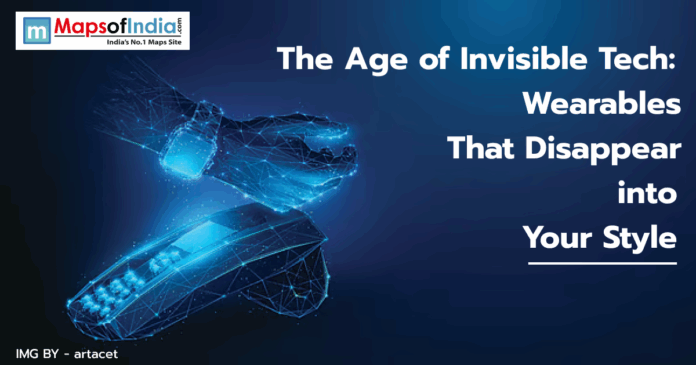The newly developed Invisible wearables technology is now reshaping fashion and technology. These invisible devices blend seamlessly with clothing. These devices track health without using any bulky gadgets. In recent years, the wearable market has hit $62 billion. According to the Statista report, it has been predicted that this technology will see 15% annual growth. From smart rings to e-textiles, innovation drives this trend. These devices monitor vitals and enhance our daily lives. Privacy and design are key concerns.
Historical Evolution of Wearables
The beginning of Wearables is seen in the 1960s. The early developed devices, like the first pedometer, were mechanical. These devices are mostly worn on the wrists. The rise of the 1980s brought digital watches. Casio’s calculator watch was a hit with everyone. This watch achieved 1 million sales. At the rise of the 2000s, we were introduced to fitness trackers. Fitbit was launched in 2009 which had clip-on designs. The development of the smartwatch also changed the healthcare industry. Smartwatches like the Apple Watch added a health monitoring system in 2015. These devices can measure heart rates with 95% accuracy. Now, this decade of the 2020s is focusing on invisibility. Tattoos and implants are being used. Flexible electronics enable this. Evolution of this technology shifts from visible to seamless integration. Wearable devices are now prioritising style over bulk.
Key Technologies Enabling Invisibility
Flexible electronics devices are core to invisible wearables. E-textiles are weaving sensors into fabric. According to the recent Nature Electronics paper, they monitor ECG with 98% accuracy. Printed circuits, which are done on skin-like materials, bend without breaking. Graphene inks conduct electricity flexibly. These devices have 100% stretchability. Miniaturized batteries are used to power devices that can last for days. Solid-state batteries can last for 500 cycles. The use of Wireless charging eliminates ports. NFC tech made data transfer possible. It also reduces the size by 40%. Bio-compatible materials ensure comfort for the customers. Silicone and polymers mimic skin colour. These technologies make wearables disappear when someone is wearing them. They blend function with fashion without anyone noticing.
Fashion Integration and Design Innovations
The newly developed invisible wearables are merging fashion and technology. When someone is wearing invisible wearables, they merge with clothing. Smart rings like Oura, track sleep without giving the feeling of wearing them. This also monitors HRV accurately. Earrings that have sensors can detect stress levels via earlobe blood flow. According to the Wearable Technologies report, 85% users are satisfied with these devices. Clothing lines have an embedded heart monitor system in sleeves. Under Armour’s recent collection uses conductive yarns. A Journal of Textile Science says they wash 50 times without loss. Tattoos that have conductive ink are useful in tracking vitals. These tattoos can last 6 months. Jewellery like smart necklaces is used to analyse posture. The design of these devices is more focused on aesthetics. According to the study conducted at the Fashion Institute of Technology, more than 70% of users prioritise style. Innovation is making tech fashionable. This is turning gadgets into accessories.
Health and Fitness Monitoring Applications
Wearable devices were always prioritised in the health sector. But the use of Invisible wearables has revolutionised health tracking. These wearables monitor vitals discreetly. Smart fabrics can detect if there are any irregularities in the heart. A Journal of Medical Internet Research study says they alert users with 92% accuracy. Sleep stages can be tracked by the ring. Oura’s recently developed model analyses REM with 89% precision. Skin patches are used to measure glucose non-invasively. According to the Diabetes Care journal article, the use of these patches reduces pricks by 80%. Fitness apps have integrated data for personalised plans. Tattoos can monitor hydration during workouts. These tattoos can show 95% accuracy in sweat analysis. These applications empower proactive health. They detect issues in early stages. Wearables like these save lives on a daily basis.
Privacy and Security Concerns
The rise of Invisible wearables has raised the issue of privacy. These devices collect sensitive health data of the users. According to the Gartner report, more than 40% of users worry about breaches. Hackers target biosensors in wearable devices for identity theft. According to the Cybersecurity Ventures article, it predicts $10.5 trillion in cybercrime costs. Regulations like GDPR mandate data protection. Manufacturers of these devices use encryption for secure transmission. The use of the blockchain adds 99% security. Users must consent before sharing the private data. According to the Pew Research Centre study, 81% of users want control over their own info. The ethical design of these devices minimizes risks. Privacy features like on-device processing are growing. Having a balance between innovation and security is crucial for these devices. Users demand trust in invisible tech.
Market Trends and Consumer Adoption
The invisible wearable market is currently on the rise. A recent Statista report predicts $62 billion will be generated in sales. The smart rings market is growing 25% yearly. Oura’s sales last year hit 1 million units. The sales of E-textiles are expected to reach $5 billion by 2028. Fitness trackers are leading this market. Consumer adoption rises 20%. An IDC Worldwide Quarterly Wearable Device Tracker notes that health focus drives 15% growth. Asia-Pacific nations are leading this market with a 40% market share. In these markets, there are many challenges, including high costs; the average cost of these devices is nearly $200-500. Trends favour integration with smart homes. Adoption depends on affordability and privacy.
Future Prospects and Innovations
Invisible wearable devices are the future of the future. Scientists believe that the technology of Neural interfaces will emerge by 2030. Bio-printed sensors will be embedded in the skin. A Nature Biotechnology paper notes 90% biocompatibility. Nanobots for internal monitoring are prototyped. These devices detect cancers early. AR glasses with health overlays grow. An Augmented Reality in Healthcare market report predicts $1.5 billion by 2025. For the sustainability of these markets, focusing on biodegradable materials is important. The eco-sensors in these devices last for 2 years. Innovations like self-charging wearables use body heat to gather body data. The future blends tech with human form seamlessly.
Conclusion
The rise of Invisible wearables is redefining technology. From historical gadgets to today’s $62 billion market, this technology has evolved a lot. Flexible electronics and AI enable seamless integration in these devices. Fashion is also a main focus of these devices. Smart rings and e-textiles are more focused on it. Health monitoring is becoming discreet and accurate. Privacy challenges are still there, and to tackle that, we need an ethical design. Future innovations like neural interfaces are promising. Invisible tech has enhanced our daily lives without causing any major problems. It’s the age of style-meets-function.





